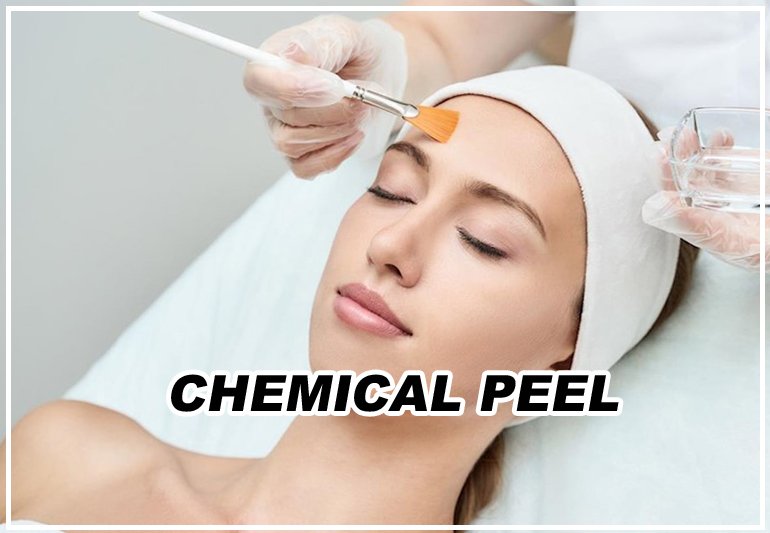Meet Our Doctor


Dr. Neha Rajesh Rathi
Consultant Dermatologist & Cosmetologist
Chemical Peel

What is Chemical Peel

What can I expect after a chemical peel?

After a chemical peel, most people experience some facial swelling and reddening. Your doctor may advise you to keep your head elevated. The recovery period is different for each type of chemical peel. Here’s what you might expect:
- Light peels — Generally cause some flaking, redness and dryness, or skin irritation. These side effects diminish over time. Once the body heals itself naturally, the outer layer of skin will fall away. Patients are usually able to engage in normal public activities the day after a light peel.
- Medium peels — May cause significant swelling, depending on the potency of the chemical solution that was used. Swelling should diminish after the first week. The skin will heal sufficiently to resume normal activities in approximately 7-10 days Deep peels — Your doctor may prescribe a mild pain medication to relieve any discomfort. If a waterproof adhesive is applied to the treated area, it will be removed in 1-2 days, and you’ll be instructed to cover the area with antiseptic powder several times a day. A scab will form and, within 7-10 days, new skin will form. While the skin will be red at first, the color will lighten over a few weeks to a few months.
Symptoms of Chemical Peel

Redness: After a chemical peel, it is normal to experience redness in the treated area. The intensity and duration of redness depend on the depth of the peel.
Peeling and flaking: As the outermost layers of the skin exfoliate, you may notice peeling and flaking. This typically occurs within a few days to a week after the procedure.
Dryness and tightness: Chemical peels can temporarily disrupt the skin’s natural moisture barrier, leading to dryness and a sensation of tightness. This usually resolves as the skin heals and renews itself.
Chemical Peel Treatment

Chemical peels are a cosmetic procedure used to improve the appearance of the skin on the face, neck, or hands. They involve the application of a chemical solution to the skin, which causes it to exfoliate and eventually peel off. This process helps to remove dead skin cells, stimulate collagen production, and reveal a smoother, rejuvenated complexion.
There are different types of chemical peels available, ranging from superficial to deep peels. The choice of peel depends on the specific skin concerns and desired results. Common types of chemical peels include:
Superficial Peel: Also known as a lunchtime peel, this type of peel uses mild acids (such as alpha-hydroxy acids, AHAs) to gently exfoliate the outer layer of the skin. It can improve skin texture, tone, and mild discoloration. Superficial peels usually require little to no downtime, and multiple treatments may be needed to achieve optimal results.
Medium Peel: Medium peels penetrate deeper into the skin using stronger acids (such as trichloroacetic acid, TCA). They are effective in treating sun damage, wrinkles, and moderate skin discoloration. Medium peels typically require a longer recovery period, and sun protection is essential during the healing process.
Deep Peel: Deep peels use stronger chemicals, such as phenol, to deeply penetrate the skin and provide more dramatic results. They are suitable for treating severe wrinkles, significant sun damage, and certain precancerous growths. Deep peels require significant downtime for proper healing, and careful post-treatment care is necessary.
Benefits of Chemical Peel Treatment

- Comprehensive list of the benefits of chemical peels, such as:
- Smoothing out fine lines and wrinkles.
- Minimizing the appearance of acne scars and other facial blemishes.
- Improving skin texture and tone.
- Enhancing collagen production for firmer, more youthful skin.
- Reducing the visibility of hyperpigmentation and sun damage.
- Helping with acne and breakouts.
- Real-life testimonials or success stories from individuals who have undergone chemical peel treatment.
The Chemical Peel Procedure

Step-by-step explanation of the chemical peel process, including:
- Pre-treatment preparation and consultation.
- Application of the chemical solution.
- Duration of the treatment and what to expect during the procedure.
- Sensations and potential side effects during and after the peel.
- Post-treatment care instructions and guidelines.
Choosing a Qualified Provider

- Importance of selecting a reputable and experienced dermatologist or skincare professional for safe and effective treatment.
- Tips for finding a trusted provider who specializes in chemical peels.
- Questions to ask during the consultation to ensure you receive the best possible care.
Conclusion

